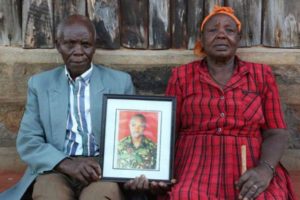BY SHARE THIS ARTICLE

Daniel Wairia and Agatha Nduta hold a portrait of their son Corporal Peter Ndegwa 39, who was killed during the El Adde attack. (PHOTO:KIBATA KIHU/STANDARD)
Kenya marks the first anniversary of an attack on a military camp in Somalia on Sunday.
Nearly 150 soldiers from the Eldoret-based 9th Kenya Riffles Battalion died in the dawn ambush by Al Shabaab fighters who also reportedly took hostages in El Adde.
Different accounts place the number of captives at a dozen including 40-year old Leonard Maingi Kiiyo who was paraded by the militants in a propaganda video released last September.
In the video, Maingi pleads with President Uhuru Kenyatta to intercede by opening negotiations with the terror group, and possibly pay ransom to grant their release.
“Mr President, this may be the last chance to plead with you as my commander that I swore to serve and one that I love. Please, I’m begging you Mr President,” Mr Maingi pleads in the video.
The video served as the strongest confirmation of prisoners of war from the attack, prompting his family in Kenya to make another appeal for the State to reach out to the militants.
HEAVY LOSSES
He and 200 other soldiers of his company had arrived in Somalia on New Year’s Day in 2016, partly explaining the heavy losses suffered as the soldiers were fairly new to the environment.
A week after the attack, the Kenya Defence Forces dispatched an enquiry team to investigate the circumstances under which the attack happened and how the massive fatalities were suffered.
It was expected that the findings would be made public but never to be, only that little remedial steps were taken months later to improve the relations between the KDF and the local community.
Independent investigations cite that severed relations and hate for the Kenyan forces by the natives aided the militants in planning and executing the attack.
Before the Friday morning ambush, the militants had damaged the local wireless communication tower which investigators later linked to the preparations for the battle.
t was common knowledge, except to KDF personnel, that a raid on the Kenyan camp was imminent at any time and that the intelligence had supposedly been shared but not acted upon.
At the centre of the probe enquiry was why the nearby camp of the Somalia National Army, about 600 metres away, was not manned hours before the ambush was staged.
A report on the attack done by Paul Williams, Associate Professor at the George Washington University, for the International Peace Institute, notes that elders in El Adde were aware of the planned attack.
“Elders in the town told these remaining troops that an al-Shabaab attack was possible,” Williams’ report reads in part, adding that in the week of the attack, fewer than 30 SNA troops were in El Adde.
The SNA camp was originally set up to hold 300 soldiers who were trained by the Kenyan military, only for the numbers to reduce steadily as most were taken up to be politicans’ bodyguards while others deserted duty over nonpayment of salaries.
Elders of the town had specific instructions for the SNA men, conveying the message from the Al Shabaab of the three options open to them.
“The elders claimed al-Shabaab had granted them three options: melt into the town’s populace, leave El Adde and go to Garbaharey or Elwak, or die alongside the Kenyans,” Williams reports, citing that the Somali troops heeded the warning.
As a result, the SNA base was empty at the time of the attack in a classic case of betrayal.
Immediately after the attack, Al Shabaab claimed responsibility through audio and video posts of celebration to aggravate Kenya’s anger.
Source: Standard Digital


